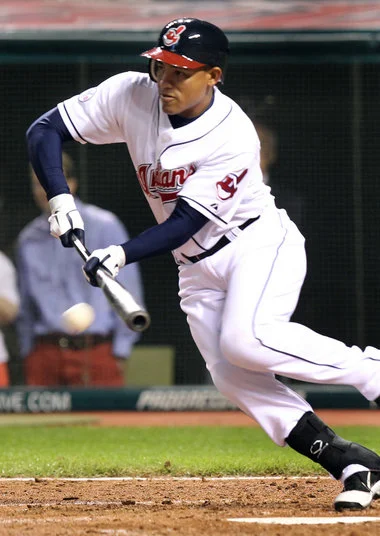There are a number of different kinds of bunts for different situations: the sacrifice, squeeze, drag, push, and slug bunts. Each kind of bunt has its own set of nuances but there are principles that govern all. The first principle is to always bunt first and then run. Trying to run before performing the action of the bunt will result in failure more often than not. The second principle is to bunt strikes and take balls. The final principle is to bunt the first strike every time. The opportunity to get the bunt down at the right time is paramount. Abiding by these principles will allow any type of bunt to be successful.
The sacrifice bunt requires a willingness to give up your at bat for the good of the offense, the good of the team. The hitter should cheat up in the batter’s box, as close to the front as possible, in order to get better plate coverage and to take advantage of the full 90 degrees of the base angles. The timing of the sacrifice bunt is a matter of coach’s discretion. Some coaches desire their players to show very early, even as the pitcher gets into his set position. Some coaches prefer to eliminate the surprise element altogether daring the defense to take the risk of getting the force out, hoping to force a mistake by the defense. Virtually all pro teams and most college teams don’t show until after the pitcher comes to the set position, lifts his leg and breaks his hands. No matter the timing, bunting before running, bunting strikes, and bunting the first strike are the most important elements in executing the sacrifice bunt. The following movie is an instructional piece highlighting the techniques of the sacrifice bunt.
The squeeze bunt is an aggressive, high-percentage play that occurs when a player bunts with a runner on third base. There are two kinds of squeeze bunts - the typical squeeze bunt play and the safety squeeze bunt play. The difference between the two plays exists in the timing. The typical squeeze play requires the runner and hitter to act when the stride foot of the pitcher hits the dirt. The runner breaks for home and the hitter squares to bunt right as the pitcher’s foot touches the ground. It is essential for the hitter to get the bunt down in order to protect and score the runner. The safety squeeze play is a drag or a push bunt from the hitter while the runner reads the downward angle of the bunt before breaking after an great secondary lead. Both plays, when executed properly, provide runs for the offense and serve to demoralize the defense. In the case of the video, Oregon uses the typical squeeze bunt to win a game late in the PAC-12 conference tournament in 2013.
The drag bunt, for both right-handed and left-handed hitters, is one that is often hurried and poorly executed. The common misunderstanding about the drag bunt is that it must be executed in a hurry and with total surprise. In fact, minimizing the movement by the hitter, using the same techniques as the sacrifice bunt, and finding the right opportunity allows the drag bunt to be successful. The hitter should move to the front edge of the plate and square with similar timing as the squeeze bunt - when the pitcher reaches foot strike with his front foot. However, timing is less important than placement of the bunt. Looking to bunt against a corner who is playing back (third baseman for the right-handed hitter, first baseman for the left-handed hitter) and placing the ball up that line will make the drag bunt successful. This is one bunt situation where being perfect or being foul are both acceptable. As with the sacrifice bunt, here is a video explaining the drag bunt.
The push bunt, executed by right-handed hitters to the first-base side of the field, causes potential confusion for the defense. The push bunt should be placed in an area that causes just a moment of uncertainty for the defense. It should be in a place that forces the pitcher, first baseman, and the second baseman a moment to decide who is fielding the ball and who is covering first base. A well-placed bunt and a hustling runner can beat a play at first base this way. A push bunt in a first-and-third situation, or any situation where the first baseman is holding a runner, can cause problems like the one in the movie below.
The slug bunt is like the push bunt for the left-handed hitter but requires a specific situation. The hitter would square to bunt early and as the third baseman charges to field the bunt, the hitter bunts the ball in between the third baseman and the pitcher, in the direction of the shortstop. This results in an easy single yet takes a tremendous amount of skill to execute.


